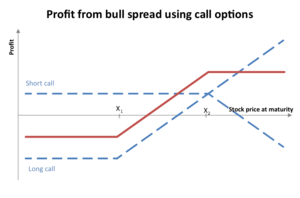Bull spread
In options trading, a bull spread is a bullish, vertical spread options strategy that is designed to profit from a moderate rise in the price of the underlying security.
Because of put-call parity, a bull spread can be constructed using either put options or call options. If constructed using calls, it is a bull call spread. If constructed using puts, it is a bull put spread.
Bull call spread
A bull call spread is constructed by buying a call option with a low strike price (K), and selling another call option with a higher strike price.


Often the call with the lower exercise price will be at-the-money while the call with the higher exercise price is out-of-the-money. Both calls must have the same underlying security and expiration month. If the bull call spread is done so that both the sold and bought calls expire on the same day, it is a vertical debit call spread.
Break even point= Lower strike price+ Net premium paid
Example
Take an arbitrary stock XYZ currently priced at $100. Furthermore, assume it is a standard option, meaning every option contract controls 100 shares.
Assume that for the next month, a call option with a strike price of $100 costs $3 per share, or $300 per contract, while a call option with a strike price of $115 is selling at $1 per share, or $100 per contract.
A trader can then buy a long position on the $100 strike price option for $300 and sell a short position on the $115 option (aka write a $115 call) for $100. The net debit for this trade then is $300 - 100 = $200.
This trade results in a profitable trade if the stock closes on expiry above 102. If the stock's closing price on expiry is $110, the $100 call option will end at $10 a share, or $1000 per contract, while the $115 call option expires worthless. Hence a total profit of $1000 - 200 = $800.
The trade's profit is limited to $13 per share, which is the difference in strike prices minus the net debit (15 - 2). The maximum loss possible on the trade equals $2 per share, the net debit.
Bull put spread
A bull put spread is constructed by selling higher striking in-the-money put options and buying the same number of lower striking out-of-the-money put options on the same underlying security with the same expiration date. The options trader employing this strategy hopes that the price of the underlying security goes up far enough such that the written put options expire worthless.
If the bull put spread is done so that both the sold and bought put expire on the same day, it is a vertical credit put spread.
Break even point=upper strike price- Net premium paid
Example
Take an arbitrary stock ABC currently priced at $100. Furthermore, assume again that it is a standard option, meaning every option contract controls 100 shares. Trader is expecting that the price of the stock will rise.

Assume that for next month, a put option with a strike price of $105 costs $8 per share, or $800 per contract, while a put option with a strike price of $125 is selling at $27 per share, or $2700 per contract.
A trader can then open a long position on the $105 strike put option for $800 and open a short position on the $125 put option for $2700. The net credit for this trade then is $2700 - 800 = $1900.
This trade will be profitable if the stock closes on expiry above $106. If the stock's closing price on expiry is $110, the $105 put option will expire worthless while the $125 put option will end at $15 a share, or $1500 per contract. Hence a total profit of $1900 - 1500 = $400.
The trade's profit is limited to $19 per share, which is equal to the net credit. The maximum loss on the trade is $1 per share which is the difference in strike prices minus the net credit (20 - 19).
Comment: This example seems wrong to me. If you're short a put with a $125 strike and the stock closes at $110 on expiration date, then that put will be $15 in the red. You'll have to buy it back for that much, or the option will be exercised and you'll be "put" the stock at $125 per share. This example, illustrates a loss, not a gain.
Comment to the comment above: the put with $125 strike price will worth less given the stock price has RAISED 10 dollars from $100; therefore, the value of put option will decrease $10 to a new value of $17. the profit from short selling is $1000, and the lose from long put in this case, should be $800, since now the market price> the strike price @ 105.
References
- McMillan, Lawrence G. (2002). Options as a Strategic Investment (4th ed. ed.). New York : New York Institute of Finance. ISBN 0-7352-0197-8.
| ||||||||||||||||||||||||||||||||||||||||||||||||
The bull put spread is explained as selling ITM put and buying OTM put, while in the example both puts are ITM.